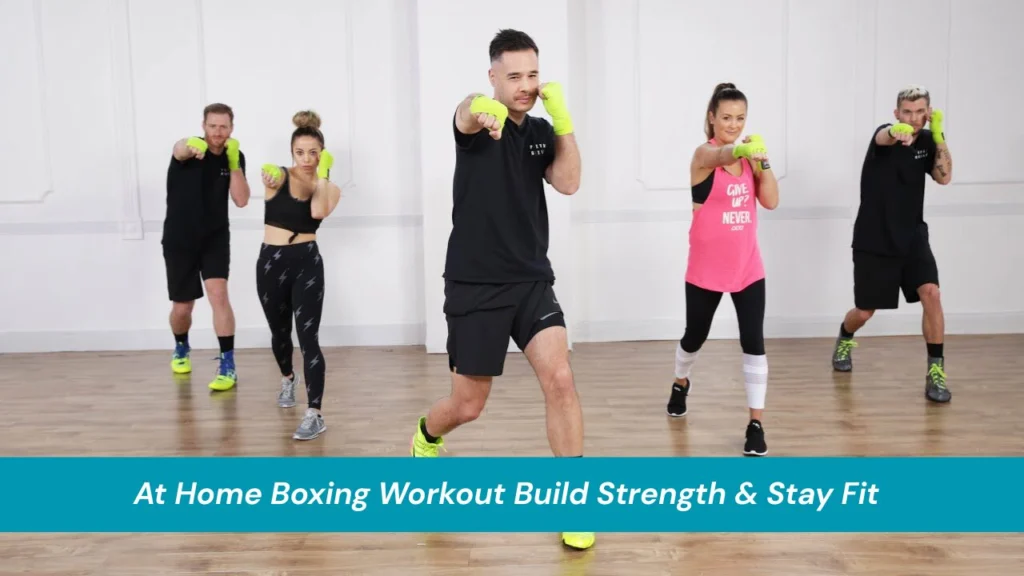Boxing has always carried a certain mystique. It’s a sport that combines power, precision, and endurance, demanding both physical toughness and mental discipline. For many people, though, boxing feels intimidating, something reserved for professional fighters, elite athletes, or those who have access to a well-equipped gym. But the truth is you don’t need a gym membership, a sparring partner, or even a boxing ring to reap the incredible benefits of the sport. With the right approach, an at home boxing workout can be just as effective as training in a professional setting.
In fact, boxing from home is becoming increasingly popular for those who want to torch calories, build strength, and boost endurance all while enjoying the convenience of exercising in their own space. Whether you’re short on time, want to save money, or simply prefer training alone, boxing at home offers a practical and powerful way to stay in shape. This guide will take you step by step through why boxing is such an effective workout, how to set up your home training space, and the routines you can follow to see real results.
Why Choose Boxing as a Home Workout?
Boxing isn’t just about throwing punches; it’s a full-body workout that can completely transform your fitness. Unlike jogging on a treadmill or lifting weights in isolation, boxing forces you to engage your entire body at once. Every jab and hook requires core rotation, balance, and explosive movement. Even your legs are constantly active, powering your footwork and driving force into your punches.
One of the greatest advantages of boxing at home is its efficiency. A single session can burn between 500 and 800 calories depending on the intensity, which makes it one of the most calorie-torching workouts you can do without expensive equipment. Beyond fat loss, boxing builds muscular endurance and strength by targeting your arms, shoulders, core, and legs in dynamic ways. You’re not just standing still and pushing weight; you’re twisting, pivoting, ducking, and striking, all of which condition your body in a functional, athletic manner.
Boxing also sharpens your coordination and agility. Because you must connect your hands, eyes, and feet, every workout improves your reflexes and motor skills. This makes it an ideal form of cross-training for athletes in other sports, or simply for anyone who wants to feel more balanced and agile in daily life. And let’s not forget the mental benefits: few workouts relieve stress as effectively as throwing punches. The rhythm of combinations and the physical release of hitting a bag (or even shadowboxing) can clear your head and boost your mood.
Setting Up for an At Home Boxing Workout
The beauty of boxing at home is that you don’t need much to get started. At its simplest, you only need a small open area where you can move freely without bumping into furniture or walls. Shadowboxing, which involves practicing punches and footwork in the air, requires no equipment at all but still provides a challenging workout.
If you want to take your training further, consider investing in some basic gear. A pair of boxing gloves and hand wraps will protect your wrists and knuckles when you begin working with a bag. A heavy bag or a freestanding punching bag adds resistance to your punches and gives you the satisfaction of striking a real target. Many people also use a skipping rope, which is a classic boxing tool for improving cardio endurance and footwork coordination. Finally, a timer or a boxing app can help you mimic the structure of real boxing rounds, ensuring you’re pushing yourself at the right intervals.
It’s important to remember that you don’t need to spend a fortune. Even with no gear at all, shadowboxing and bodyweight conditioning can give you a workout that rivals any gym routine. Equipment simply enhances the variety and resistance of your sessions.
The Fundamentals Boxing Moves Everyone Should Master
Before diving into structured routines, it’s worth breaking down the foundational moves. Every boxing workout revolves around a handful of core punches and defensive maneuvers. The jab is your lead punch, quick and straight, perfect for setting up combinations. The cross, delivered with your rear hand, carries more power and often follows the jab in a classic “one-two” sequence. Hooks target the sides of your opponent and require rotational force from your hips, while uppercuts drive upward through the guard, engaging your legs and core.
Equally important is your stance and footwork. Keep your knees slightly bent, weight distributed evenly, and hands up to protect your face. Small, controlled steps forward, backward, and sideways allow you to stay mobile and balanced. Even when you’re training alone, practicing these fundamentals builds the muscle memory necessary for a strong boxing foundation.
A Beginner-Friendly At Home Boxing Workout
If you’re new to boxing, start with a routine that builds technique and fitness simultaneously. Begin with a warm-up of dynamic stretching and light cardio, such as jogging in place or skipping rope for three minutes. This primes your muscles and joints for the explosive movements ahead.
Once warmed up, transition into shadowboxing. Spend three minutes practicing your jab, cross, hook, and uppercut, focusing on clean form rather than speed. Visualize an opponent in front of you and move around the space, integrating footwork with your punches. This not only improves technique but also elevates your heart rate.
Next, incorporate bag work if you have access to one. Throw combinations such as jab-cross or hook-cross-hook with moderate intensity, aiming for consistency and rhythm. If you don’t have a bag, continue shadowboxing with greater speed and intention.
To build conditioning, add a bodyweight circuit. Perform sets of push-ups, squats, and mountain climbers in quick succession. These exercises complement your boxing by strengthening the same muscle groups used in punching and maintaining stance. Finally, finish with a core session including planks, Russian twists, and leg raises. Strong core muscles are essential for generating power in every strike.
This workout should last around 30 to 40 minutes and can be repeated three to four times per week.
An Advanced At Home Boxing Workout for Greater Challenge
Once you’re comfortable with the basics, it’s time to increase the intensity. Advanced routines should simulate the pace of an actual fight by mixing periods of all-out effort with short rests. Begin with five minutes of jump rope, alternating between steady rhythm and double-unders to test your coordination.
Then move into high-intensity shadowboxing rounds. Use a timer and push yourself to throw punches as fast as possible for 20 seconds, followed by 10 seconds of rest. Repeat this pattern for three minutes, then rest one minute before starting again. This style of interval training improves both cardiovascular endurance and punching speed.
On the heavy bag, practice more complex combinations such as jab-cross-hook-uppercut or jab-jab-cross-hook. Between combos, integrate defensive moves like slips, ducks, and pivots. The key is to mimic the flow of a real fight, not just stand and punch.
For conditioning, perform a punch-out drill: throw nonstop punches at the bag or in the air for 30 to 60 seconds, then rest for 15 seconds. Repeat several times. This is exhausting but extremely effective for stamina. Conclude your session with explosive bodyweight exercises such as burpees, jump squats, and plyometric push-ups. These mimic the explosive energy required in boxing matches.
How to Stay Motivated and Consistent
The biggest challenge with any at-home workout is consistency. Without the accountability of a trainer or a gym environment, it’s easy to skip sessions. To combat this, treat your training like an appointment. Schedule specific times during the week and commit to them as you would a meeting or class.
Tracking progress can also boost motivation. Keep a journal of your rounds, the combinations you practiced, and how you felt after each session. Over time, you’ll notice improvements in endurance, speed, and power, which reinforces your commitment.
Another tip is to mix up your routines to prevent boredom. Rotate between shadowboxing, bag work, and conditioning circuits. You can also follow online boxing classes or tutorials to learn new drills. Some people find that creating a workout playlist helps maintain energy and focus throughout the session.
Nutrition and Recovery for Boxers Training at Home
No workout program is complete without attention to nutrition and recovery. Boxing is demanding, and your body needs the right fuel to perform and recover. Prioritize lean protein sources such as chicken, fish, eggs, or plant-based options to repair muscles. Pair these with complex carbohydrates like brown rice, quinoa, or sweet potatoes to provide sustained energy. Don’t neglect healthy fats from sources like avocados, nuts, and olive oil, which support hormone balance and joint health.
Hydration is another key factor. Sweating through intense rounds of boxing can deplete electrolytes, so drink plenty of water before, during, and after workouts. For longer sessions, consider adding a sports drink or coconut water for replenishment.
Recovery is equally vital. Muscles grow and adapt during rest, not during training itself. Ensure you’re getting seven to nine hours of sleep per night and incorporate rest days into your weekly schedule. Stretching, foam rolling, or light yoga can also aid in recovery by reducing muscle tension and improving flexibility.
Common Mistakes to Avoid in At Home Boxing
While boxing at home is highly effective, beginners often fall into a few traps. One common mistake is focusing solely on punching speed without paying attention to form. Poor technique can lead to injuries and limit your power output. Always prioritize clean movements over raw speed.
Another error is neglecting footwork. Many people stand still while throwing punches, but boxing is just as much about movement as striking. Practice stepping forward, backward, and sideways while maintaining balance. This will improve agility and help you generate more effective punches.
Finally, some beginners overtrain, thinking more is always better. Boxing is intense, and without proper rest, you risk burnout or injury. Stick to structured routines and gradually increase intensity as your fitness improves.
FAQs
Can I learn boxing effectively at home without a coach?
Yes, beginners can learn the fundamentals through shadowboxing and online tutorials. However, working with a trainer even virtually can help you refine technique and avoid bad habits that are difficult to correct later.
How long should my boxing workouts last?
Most effective sessions last between 30 and 60 minutes, including warm-up and cool-down. Beginners may start with shorter sessions, while more advanced athletes can handle longer routines with added conditioning.
Do I need a punching bag to benefit from boxing?
A punching bag is useful for developing power and resistance, but it isn’t essential. Shadowboxing provides excellent cardio conditioning, coordination, and technique practice. Many professional fighters use shadowboxing as a core part of their training.
Is boxing safe for beginners?
Boxing is safe as long as you prioritize technique and gradually increase intensity. Always use wraps and gloves when hitting a bag to protect your hands and wrists. Beginners should avoid sparring until they have proper guidance.
Can boxing replace my usual cardio workouts?
Absolutely. Boxing is a form of high-intensity interval training that challenges both aerobic and anaerobic systems. It burns more calories than steady-state cardio like jogging while also building strength and coordination.
Conclusion
An at home boxing workout is more than just a convenient alternative to the gym; it’s a transformative fitness practice that builds strength, endurance, and confidence. With little more than open space and motivation, you can start training like a fighter today. Whether your goal is to lose weight, gain muscle, or simply relieve stress, boxing provides a dynamic and engaging way to reach your fitness goals.
The key is consistency. Treat your workouts as non-negotiable, fuel your body properly, and keep your routines challenging. Over time, you’ll notice not only physical changes but also greater mental toughness and resilience. Boxing isn’t just about fighting opponents, it’s about pushing past your own limits.
So clear some space in your living room, lace up your gloves if you have them, and throw your first jab. You don’t need a ring to train like a fighter. You just need discipline, focus, and the willingness to get started today. Visit Boxing Essential to explore more.




